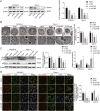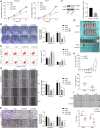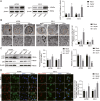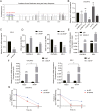Regulation of ULK1 by WTAP/IGF2BP3 axis enhances mitophagy and progression in epithelial ovarian cancer
- PMID: 38286802
- PMCID: PMC10824720
- DOI: 10.1038/s41419-024-06477-0
Regulation of ULK1 by WTAP/IGF2BP3 axis enhances mitophagy and progression in epithelial ovarian cancer
Abstract
There is a pressing need for innovative therapeutic strategies for patients with epithelial ovarian cancer (EOC). Previous studies have shown that UNC-51-like kinase 1 (ULK1), a serine/threonine kinase, is crucial in regulating cellular autophagy and mitophagy across various tumor types. However, the clinical implications, biological functions, and potential mechanisms of ULK1 in EOC remain poorly understood. This study demonstrates that ULK1 expression is upregulated in EOC tissue samples and EOC cell lines, with increased ULK1 expression correlating with poor prognosis. Functionally, overexpressed ULK1 enhances the proliferation and migration abilities of EOC cells both in vitro and in vivo. Mechanistically, ULK1 was identified as an m6A target of WTAP. WTAP-mediated m6A modification of ULK1 enhanced its mRNA stability in an IGF2BP3-dependent manner, leading to elevated ULK1 expression and enhanced mitophagy in EOC. In summary, our research reveals that the WTAP/IGF2BP3-ULK1 axis significantly influences protective mitophagy in EOC, contributing to its progression. Therefore, the regulatory mechanisms and biological function of ULK1 identify it as a potential molecular target for therapeutic intervention in EOC.
© 2024. The Author(s).
Conflict of interest statement
The authors declare no competing interests.
Figures








Similar articles
-
CircFAM188A Regulates Autophagy via miR-670-3p and ULK1 in Epithelial Ovarian Carcinoma.Cancer Rep (Hoboken). 2024 Sep;7(9):e2128. doi: 10.1002/cnr2.2128. Cancer Rep (Hoboken). 2024. PMID: 39229655 Free PMC article.
-
Circ-PGAM1 promotes malignant progression of epithelial ovarian cancer through regulation of the miR-542-3p/CDC5L/PEAK1 pathway.Cancer Med. 2020 May;9(10):3500-3521. doi: 10.1002/cam4.2929. Epub 2020 Mar 13. Cancer Med. 2020. PMID: 32167655 Free PMC article.
-
Enterolactone combined with m6A Reader IGF2BP3 inhibits malignant angiogenesis and disease progression in ovarian cancer.Phytomedicine. 2025 Jan;136:156343. doi: 10.1016/j.phymed.2024.156343. Epub 2024 Dec 21. Phytomedicine. 2025. PMID: 39765033
-
Function and regulation of ULK1: From physiology to pathology.Gene. 2022 Oct 5;840:146772. doi: 10.1016/j.gene.2022.146772. Epub 2022 Jul 26. Gene. 2022. PMID: 35905845 Review.
-
A patent review of UNC-51-like kinase 1/2 inhibitors (2019-present).Expert Opin Ther Pat. 2025 Jan;35(1):7-16. doi: 10.1080/13543776.2024.2423010. Epub 2024 Nov 4. Expert Opin Ther Pat. 2025. PMID: 39470442 Review.
Cited by
-
Single-cell transcriptome analysis revealed heterogeneity in glycolysis and identified IGF2 as a therapeutic target for ovarian cancer subtypes.BMC Cancer. 2024 Jul 31;24(1):926. doi: 10.1186/s12885-024-12688-7. BMC Cancer. 2024. PMID: 39085784 Free PMC article.
-
The role of m6A modified circ0049271 induced by MNNG in precancerous lesions of gastric cancer.Heliyon. 2024 Aug 3;10(16):e35654. doi: 10.1016/j.heliyon.2024.e35654. eCollection 2024 Aug 30. Heliyon. 2024. PMID: 39224358 Free PMC article.
-
Autophagy: a critical mechanism of N6-methyladenosine modification involved in tumor progression and therapy resistance.Cell Death Dis. 2024 Oct 28;15(10):783. doi: 10.1038/s41419-024-07148-w. Cell Death Dis. 2024. PMID: 39468015 Free PMC article. Review.
-
IGF2BP3 recruits NUDT21 to regulate SPTBN1 alternative polyadenylation and drive ovarian cancer progression.Commun Biol. 2025 Apr 29;8(1):680. doi: 10.1038/s42003-025-08097-6. Commun Biol. 2025. PMID: 40301554 Free PMC article.
-
The Multifaceted Role of VIRMA, a Core Component of the Methyltransferase Complex, in Cancer and Cancer Therapy.Biomolecules. 2025 Jun 22;15(7):912. doi: 10.3390/biom15070912. Biomolecules. 2025. PMID: 40723784 Free PMC article. Review.
References
Publication types
MeSH terms
Substances
LinkOut - more resources
Full Text Sources
Medical

